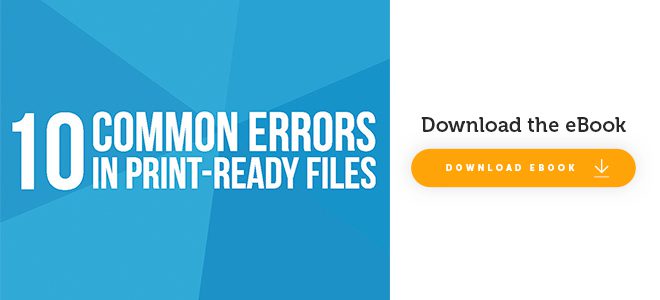Design the perfect print piece by avoiding these 10 Common Errors in Print-Ready Files!
As a printer who receives hundreds of print-files per day, we’ve seen a wide spectrum of ways designers handle things like typography, color, photography, and file setup in general. There is some flexibility in the way to setup your print-ready design files, however, it’s important to avoid these 10 common errors to ensure your beautiful design prints perfectly.


1. Spot Colors
It’s important to be consistent with spot/custom colors. A color should not be represented as a spot color and as a CMYK (Or RGB) mix in the same document. One or the other is fine, but be consistent.
2. Rich Black
Solid black boxes or panels should be tinted using these CMYK values: 65C / 55M / 53Y / 100K
3. Fonts Not Embedded
Embed all fonts. If you are absolutely sure that no editing will ever be necessary, outline them.
4. Compressed Images
Never compress images when exporting to PDF.
5. Bleed/Bleed Box/Trim Box Consistency
The rule of thumb is that all documents should have 1/8″ bleed all-around, but with automation becoming more commonplace, be aware of the actual trim box and bleed box sizes when we output to PDF.
6. Transparency & Layers
Transparency can cause files to print in very unpredictable ways. Always try to flatten your document before sending it to the printer.
7. Rules, Borders, Marks
Rules, borders and marks should never be less than .2 pt, and should be built out of a single color if you are approaching that level of fineness. Also make sure that all rules and marks that print as black are 100% black only – not CMYK mixes.
8. Image Resolution
Images should be very close to 300 dpi at the size they are printing. Low-resolution images that are up-sampled to 300dpi will get through the pre-flight process, but could reproduce poorly. Extremely large, high resolution images should be re-sized before embedding into the page layout program. For instance, if the front cover for a 8.5″ x 11″ book is created using an image that originally was used for a 36″ x 48″ poster, that image would ideally be re-sized or downsampled before inserting into the document.
9. Image Format
Images should be converted to CMYK before embedding into the page layout program. RGB images that are converted to CMYK values at the press usually produce as expected, but it’s always better to know ahead of time what your file is going to look like in CMYK before it leaves your desktop. GIF and PNG images should be avoided when preparing your document.
10. Fonts, Size/Color Mix
Any serif font printing smaller than 6pt should neither be knocked out of a solid color, nor should it be created with a process mix if printing on a white background. Knock-out type smaller than 6pt may fill in.
